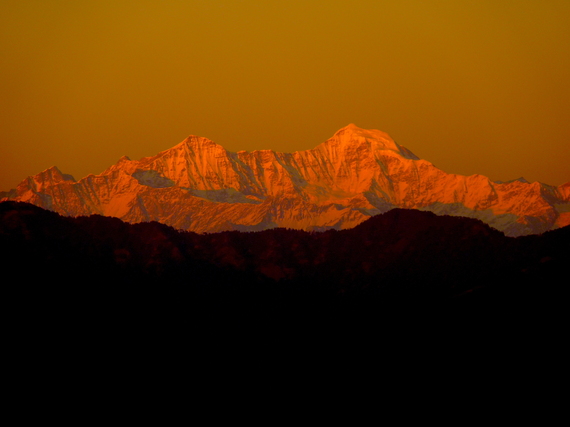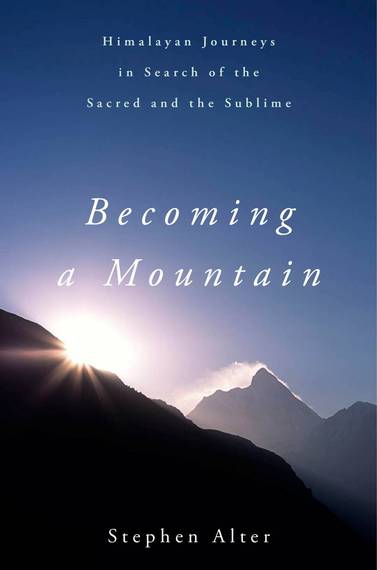Several years ago I met up with fellow writer, Ramachandra Guha. When I told him I was going to write a book about climbing a mountain, he insisted that it would be a much better story if I didn't make it to the top. Ignoring his advice, I continued with my plans to reach the summit of Bandarpunch, a 20,721 foot peak north of my home in Mussoorie, India. A spectacular mountain, as grand as any Himalayan massif, it has two summits draped in snow, and an intervening ridge that drops 10,000 feet into the Hanuman Ganga valley. Bandarpunch was climbed first by Tenzing Norgay, in 1950.
Though I'm not a mountaineer, I imagined writing an adventurous account of high altitude heroics, tents perched on snow ledges and ropes snaking up ice cliffs. In my mind, I had already fixed my crampons and gripped an ice axe in one hand. Of course, the realities of mountain climbing are far different from the fantasies we enjoy in the comfort of home. Over the years, I've had the privilege of meeting a number of distinguished climbers who have stood atop the highest points on earth and happily lived to tell the tale. So many others have perished in the Himalayas, tragic victims of avalanches, storms and altitude sickness, as well as the fatal, unforgiving force of gravity.
Now that my book is published, I can admit that when I actually got on the mountain and began kicking steps in the snow while gasping for breath, I was completely terrified. Trying not to look down at the sheer drop beneath my boots, I remember thinking Ram Guha might have made a valid point.
This story begins several years earlier when my wife, Ameeta, and I were attacked in our home by four intruders who stabbed and beat us, then left us for dead. The trauma of that experience forced me to question many of the assumptions by which I lived and to seek paths of solace in the Himalayas. Fear is probably the most difficult emotion to control for it supersedes logic and takes hold of you at times when you least expect it. The brutal violence of our attack - having a knife at my throat and being smothered by a stranger's hand - left me with a sense of vulnerability that I had never known when I was younger. Earlier, while working on another book, Sacred Waters, I walked alone throughout Garhwal, along pilgrim trails to the sources of the Ganga, careless and content to wander wherever those footpaths took me. The Himalayas are my birthplace and I never felt safer or happier than when I was trekking through these mountains. But after our attack, I was afraid to go alone, even as I craved the solitude and silence.
Climbing Bandarpunch was a journey of healing and recovery, as much as a quest for the summit. This mountain takes its name from Hanuman the monkey king who flew to the Himalayas in search of a herb of immortality. Those epic myths have always enhanced the lure of these mountains. Ancient narratives add another dimension to the geography.
In Garhwal, lore and legend mark every corner of the path. No stories are more potent or profound than the mythology of Nanda Devi, both the goddess and her sacred mountain. After turning back from my first attempt to climb Bandarpunch, I took a series of treks along the approaches to Nanda Devi. First, I followed the Curzon Trail over Kuari Pass which served as the route for many legendary mountaineers. Longstaff, Shipton, Tilman and Smythe all exclaimed over the panorama of peaks that are visible from Kuari pass, one of the most dramatic vistas in the Himalayan chain. A second trek took me to Roop Kund, a high altitude lake that is the penultimate stage of the Nanda Devi Raj Jat Yatra, or royal pilgrimage. Unlike the expansive charms of Kuari Pass, Roop Kund is a place of tragic mysteries, where the skeletons of anonymous pilgrims litter the shores of a glacial pond that melts for only a few weeks each year. The elation I experience at Kuari Pass contrasts with the fearsome isolation of the lake, evoking in me what nineteenth century writers described as an experience of "the sublime." This paradoxical sensation of awe and fear draws us to mountains, an appreciation for the beauty and magnificence of snow-clad peaks, as well as terrible secrets and dangerous obstacles that await us on their forbidding slopes.
The third mountain I approached on my peripatetic pilgrimage was Kailash, the most sacred summit of all, which lies across the main thrust of the Himalayas in Tibet. Though hardly 100 miles from Mussoorie, as the crow flies, Kailash remains remote, because of political distances and borders as much as rugged terrain. To reach there, I had to go via Kathmandu, then circle back across the Tibetan plateau, two weeks' journey by road. Accompanying a group of pilgrims Maharashtra and Gujarat, I was the lone "foreigner" in their midst, though all of us were strangers in a strange land. The circumambulation of Kailash takes us to the threshold of transcendence. Though it is not a difficult trek, the altitude at Dolma La pass, 18,500 feet, adds foreboding to the sanctity of this place. Each year a number of pilgrims succumb to altitude sickness, the dire consequences of faith.
As a non-believer who appreciates the power of myths and the spiritual resonance of high places, I respect the beliefs of those who approach the Himalayas out of reverence and religious devotion. At the same time, my own pilgrimage draws inspiration from the natural world rather than the supernatural or divine. My doubts are as powerful a motive as the absolute convictions of my Hindu or Buddhist companions.
At the end of my book, I return to Bandarpunch, attempting to climb the mountain a second time. Perhaps I wanted to prove Ram Guha wrong, when he suggested that defeat and failure are more interesting to read about than conquest and victory. Perhaps I was still looking for the healing herb that Hanuman retrieves from these Himalayan heights. Perhaps I was simply seeking to escape my discontentment and the terrifying shadows of our attack. Whatever it may be, I hope this book will allow my readers to appreciate the words of Sir Francis Younghusband when he wrote: "As we look at the Himalaya from such distance that we can see things whole and in their just proportion, the pain and disorder, squalor and strife, vanish into insignificance. We know that they are there, and we know that they are real. But we know also that more important, and just as real, is the Power which out of evil is ever making good to come... This is the true secret of the Himalaya."
For more information go to www.becomingamountain.com
A version of this article appeared in The India Quarterly.


